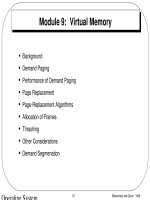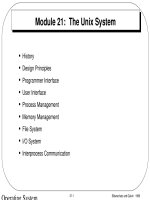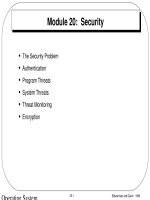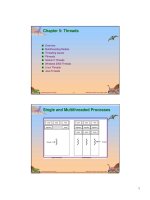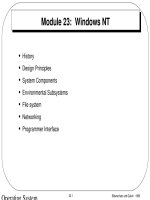Lecture Operating system concepts - Lecture 17
Bạn đang xem bản rút gọn của tài liệu. Xem và tải ngay bản đầy đủ của tài liệu tại đây (1.17 MB, 40 trang )
CSC 322 Operating Systems Concepts
Lecture - 18:
by
Ahmed Mumtaz Mustehsan
Special Thanks To:
Tanenbaum, Modern Operating Systems 3 e, (c) 2008 Prentice-Hall, Inc. (Chapter3) Silberschatz, Galvin and Gagne 2002, Operating System Concepts,
Ahmed Mumtaz Mustehsan, CIIT,
Chapter 3
Memory Management
Virtual memory
Segmentation
Lecture-17
Ahmed Mumtaz
2
Segmentation
A compiler has many tables that are built up as
compilation proceeds, possibly including:
•
The source text being saved for the printed listing
(on batch systems).
•
The symbol table – the names and attributes of
variables.
•
The table containing integer, floating-point
constants used.
•
The parse tree, the syntactic analysis of the
program.
•
The stack used for procedure calls within the
compiler.
Lecture-17
Ahmed Mumtaz
3
One dimensional address space
In a one-dimensional address space with
growing tables, one table may bump into another.
Lecture-17
Ahmed Mumtaz
4
Segmentation
A segmented memory allows each table to grow or
shrink independently of the other tables .
Lecture-17
Ahmed Mumtaz
5
Advantages of Segmentation
•
•
•
•
•
Simplifies handling of data structures which are
growing and shrinking
Address space of segment n is of form (n,local
address) where (n,0) is starting address
Can compile segments separately from other
segments
Can put library in a segment and share it
Can have different protections (r,w,x) for different
segments
Lecture-17
Ahmed Mumtaz
6
Comparison Paging vs Segmentation
Lecture-17
Ahmed Mumtaz
7
External fragging
•
•
(a)-(d) Development of checker boarding.
(e) Removal of the checker boarding by compaction.
Lecture-17
Ahmed Mumtaz
8
Swapping, a picture (Revisit)
Can compact holes by copying programs into holes
This takes too much time
Lecture-12
Ahmed Mumtaz
9
Segmentation
Logical address consists of a two tuple:
<segment-number, offset>,
Segment table – maps two-dimensional physical
Addresses; each table entry has:
base – contains the starting physical address
where the segments reside in memory.
limit – specifies the length of the segment.
Segment-table base register (STBR) points to the
segment table’s location in memory.
Segment-table length register (STLR) indicates
number of segments used by a program; segment
number s is legal if s < STLR.
Lecture-17
Ahmed Mumtaz
10
Sharing of Segmentation
Lecture-17
Ahmed Mumtaz
11
Example of Segmentation
Lecture-17
Ahmed Mumtaz
12
Segmentation H/w for Address Translation
Lecture-17
Ahmed Mumtaz
13
Segmentation with Paging
•
•
•
•
•
Examine two systems
•
Multics (the first)
•
The Pentium
Honeywell 6000
2*18 segments, up to 65,538 (36 bit) words per
segment
Each program has a segment table (paged itself)
containing segment descriptors
Segment descriptor points to page table
Lecture-17
Ahmed Mumtaz
14
Segmentation with Paging: MULTICS
The MULTICS virtual memory.
•
(a) The descriptor segment points to the page
Lecture-17
Ahmed Mumtaz
15
Tanenbaum, Modern Operating Systems 3 e, (c) 2008 Prentice-Hall, Inc. All rights reserved. 0-13-6006639
tables.
•
Segmentation with Paging
•
•
•
Segment descriptor says whether segment is in
main memory or not
If any part of segment is in memory, entire
segment is considered to be in memory
Virtual Address is (segment number, page
number, offset within page)
Lecture-17
Ahmed Mumtaz
16
Segmentation with Paging: MULTICS
The MULTICS virtual memory.
(b) A segment descriptor. The numbers are the field
Lecture-17
Ahmed Mumtaz
17
lengths.
Segmentation with Paging: MULTICS
•
A 34-bit MULTICS virtual address.
Lecture-17
Ahmed Mumtaz
18
Segmentation with Paging: MULTICS
When a memory reference occurs, the following
algorithm is carried out:
•
The segment number used to find segment
descriptor.
•
Check is made to see if the segment’s page
table is in memory.
•
If not, segment fault occurs.
•
If there is a protection violation, a fault (trap)
occurs.
Lecture-17
Ahmed Mumtaz
19
Segmentation with Paging: MULTICS
•
•
•
Page table entry for the requested virtual page
examined.
•
If the page itself is not in memory, a page fault
is triggered.
•
If it is in memory, the main memory address of
the start of the page is extracted from the
page table entry
The offset is added to the page origin to give the
main memory address where the word is located.
The read or store finally takes place.
Lecture-17
Ahmed Mumtaz
20
Segmentation with Paging: MULTICS
•
Conversion of a two-part MULTICS address into a
main memory address.
Lecture-17
Ahmed Mumtaz
21
Segmentation with Paging: MULTICS
•
Conversion of a two-part MULTICS address into a
main memory address.
Lecture-17
Ahmed Mumtaz
22
MULTICS TLB
•
•
•
•
•
•
Too many references with algorithm
Use TLB (16 words)
Keep addresses of the 16 most recently
referenced pages in TLB
Addressing hardware checks to see if address is
in TLB
If so, gets address directly from TLB
If not, invoke algorithm (check descriptor…)
Lecture-17
Ahmed Mumtaz
23
Segmentation with Paging: MULTICS (10)
Lecture-17
Ahmed Mumtaz
24
Segmentation with Paging: The Pentium
A Pentium selector.
•
•
•
The Pentium has 16K independent
segments, each holding up to 1 billion 32-bit
words
LDT (Local Descriptor Table); describes
segments local to each program
GDT (Global Descriptor
Table); describes
Lecture-17
Ahmed Mumtaz
25
